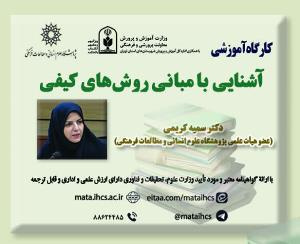الأسطوره في الشعر النسوي الحدیث العربي والغربي، (إدیث سیتویل1946، نازک الملائکه 2007) أنموذجا (مقاله علمی وزارت علوم)
درجه علمی: نشریه علمی (وزارت علوم)
آرشیو
چکیده
یعد توظیف الأسطوره من إحدى الأدوات التعبیریه الجمالیه التی اهتدى إلیها شعراء الحداثه، واستعانوا بها فی شعرهم، وقد عظم توظیفها فی الشعر الحدیث حتى غدت من أهم ظواهر الأدب الحدیث والمعاصر، وشکل استعمالها سمه من سمات الأدب الحدیث فما یکاد یکون هناک عمل شعری یخلو من الإشارات الرمزیه والأسطوریه، وفی محاوله البحث حول نمط المرأه الشاعره فی توظیفها الأسطوری، المتناغم مع الطبیعه، تخرج لنا الأسطوره، ویخلق منها صوره ماورائیه أو عجائبیه، فالأساطیر حاضره فی أشعارها، واستخدمت العدید منها فی نصوصها الشعریه حتى تحرر من خلالها رسائل نصیه تشیر إلى واقعها الشعری، وکیانها الفلسفی والفکری فی الحیاه. أتاح لنا هذا البحث وعبر المنهج التحلیلی المقارن النظر فی تجلیات الأسطوره فی الشعر النسوی، وسلط الباحثون الضوء على الأدب النسوی وتأثیر الأدب الغربی فی الثقافه العربیه من خلال عقد مقارنه بین أنموذجین من شاعرات الأدب الحدیث، متمثلا ب (إدیث سیتویل 1887- 1964 / ونازک الملائکه 1923- 2007)، إن ما جعل کتابه هذا البحث کضروره عند الباحثین هو الغایه من استحضار المضامین الأسطوریه فی قصائد الشاعرات المعاصرات، وحاولنا من خلاله طرح إشکالیه توظیف الأسطوره فی الشعر النسوی الحدیث، واستدعاء الأسطوره بشکل مکثف عند الشاعرتین. تدل النتائج على تأثیر الأدب الغربی فی التطور الشعری عند نازک بدلیل أن الرموز الإغریقیه هی المسیطره على النص الشعری عندها، کما أن هناک بعض الأساطیر الدینیه تبنتها نازک فی خطابها وفقا للروایات المسیحیه، أما إدیث فکانت تخلق رموزاً وصوراً غیر مألوفه من إبداعات عالمها الخاص، ومن خلال هذه الدراسه التوظیفه للأسطوره بین الأدبین العربی والغربی نجد صوره الأسطوره فی معالم الخیال بین الشاعرتین التی تعبر عن النص اللغوی الفنی الممزوج بالتعابیر الملائمه للواقع وکانت لنا الریاده فی استخدامها من خلال دراستنا للثقافتین، یتبین أن توظیف الأسطوره هو نوع من الرجوع إلى الحیاه البدائیه الأولىEdith Sitwell 1946 and Nazik Al Malaka 2007 as Modern Arabic and Western Feminist Poetry Role Models
Employing myth is one of the aesthetic expressive tools used by modern poets in their poetry. Its use in modern poetry is so prevalent that it has become one of the most important phenomena in modern and contemporary literature, distinguishing it as a feature of modern literature. Almost every poetic work contains symbolic and mythological references. In an attempt to find a style that harmonizes with nature, female poets often incorporate myth, creating metaphorical or miraculous images. Myths are present in the poems of women poets, and many of them utilize these myths to convey messages about their poetic conditions, as well as their philosophical and intellectual existence in life.This study adopts a comparative analytical approach to reveal the manifestations of myth in feminist poetry. The researcher sheds light on feminist literature and the influence of Western literature on Arab culture through a comparison between two examples of female poets from modern literature: Edith Sitwell (1887-1964) and Nazik Al-Malaika (1923-2007). The aim of this study is to explore the mythological content in the poems of contemporary female poets, specifically focusing on how myth is employed in modern feminist poetry and its intensive invocation between these two poets.The results indicate that there is an influence of Western literature on the poetic development of Nazik Al-Malaika, with evidence showing that Greek symbols dominate her poetic texts. Additionally, she incorporates some religious myths based on Christian narratives into her discourse. On the other hand, Edith Sitwell creates unfamiliar symbols and images from her own imaginative world.Through this study of the employment of myth in Arab and Western literature, the mythic image is manifested in the imaginative features of the two poets. This expression of artistic linguistic text is blended with elements that are relevant to reality. The present study represents the first attempt to explore this concept by examining both cultures. It becomes evident that the use of myth serves as a means to revisit the primal origins of life.







